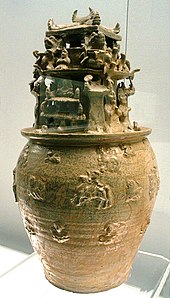

The hunping (Chinese: 魂瓶; pinyin: Húnpíng), translated as soul jar or soul vase, is a type of ceramic funerary urn often found in the tombs of the Han dynasty and especially the Six Dynasties periods of early imperial China.[1] It was characteristic of the Jiangnan region in modern southern Jiangsu and Zhejiang provinces.[2]
The purpose of a hunping is somewhat enigmatic, but archaeologists suggest that they may have been used as containers for fruit accompanying the deceased into the afterlife.[1] According to the Metropolitan Museum of Art, the ancients may have hoped that the soul of the deceased would eventually reside in the vessel.[2]
Since the last decades of the Han dynasty, the top of hunping vessels started to be decorated with miniature sculptures of men, animals, birds, etc. Gradually, sculptural compositions became more elaborate, including images of entire buildings.[1]
It is due to an early-Jin dynasty hunping, dating to 272, that an early example of a tortoise-born stele is known to us.[3]
See also
[edit]Notes
[edit]- ^ a b c Dien, Albert E. (2007), Six dynasties civilization, Early Chinese civilization series, Yale University Press, pp. 214–215, ISBN 978-0-300-07404-8
- ^ a b Funerary urn (hunping), Western Jin dynasty (265–317), ca. 250–300. China. Earthenware with green glaze. (1992.165.21) (The Metropolitan Museum of Art)
- ^ Abe, Stanley K. (2002), Ordinary images, University of Chicago Press, pp. 71–72, ISBN 0-226-00044-3
External links
[edit]- A Handbook of Chinese Ceramics from The Metropolitan Museum of Art

Well, that’s interesting to know that Psilotum nudum are known as whisk ferns. Psilotum nudum is the commoner species of the two. While the P. flaccidum is a rare species and is found in the tropical islands. Both the species are usually epiphytic in habit and grow upon tree ferns. These species may also be terrestrial and grow in humus or in the crevices of the rocks.
View the detailed Guide of Psilotum nudum: Detailed Study Of Psilotum Nudum (Whisk Fern), Classification, Anatomy, Reproduction